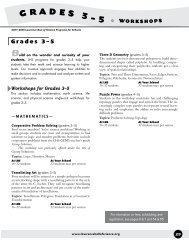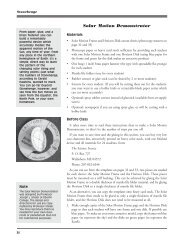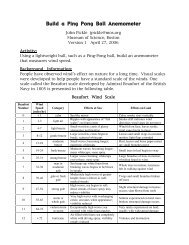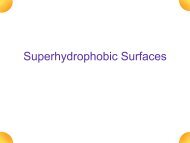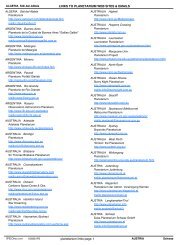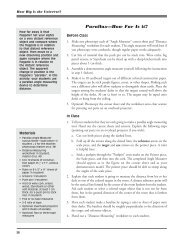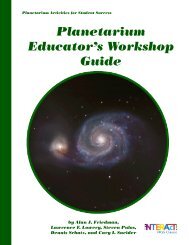SOLAR SYSTEM SCIENCE - Lawrence Hall of Science
SOLAR SYSTEM SCIENCE - Lawrence Hall of Science
SOLAR SYSTEM SCIENCE - Lawrence Hall of Science
You also want an ePaper? Increase the reach of your titles
YUMPU automatically turns print PDFs into web optimized ePapers that Google loves.
Min/Max Setting<br />
End <strong>of</strong> the comet tail<br />
Min ___________ Max __________ x = ______, y = ______ Counts = _________<br />
Min ___________ Max __________ x = ______, y = ______ Counts = _________<br />
Question 25. Where is the end <strong>of</strong> the<br />
comet’s tail? Find the pixel that<br />
is at the “very end” <strong>of</strong> the comet’s<br />
tail and write its coordinates,<br />
brightness counts, and color. Note<br />
the “length” <strong>of</strong> the tail can seem<br />
to change with different Min/Max<br />
settings. Record and compare (in<br />
the box above) the end <strong>of</strong> the tail<br />
for two different Min/Max settings.<br />
7. About False Color. False color imaging<br />
is becoming a widely spread means <strong>of</strong><br />
communication; e.g., weather maps. By<br />
creating your own color image <strong>of</strong> the comet,<br />
you control how the Image Processing s<strong>of</strong>tware<br />
displays data to make particular details easier<br />
to see.<br />
The Color Palette Bar (activated from<br />
the “View” menu), is a chart showing the<br />
relationship between either (a) shade <strong>of</strong><br />
grey and pixel brightness or (b) color and<br />
pixel brightness, depending on what palette<br />
is selected in the Palette Menu. It helps you<br />
see the changes in brightness over the whole<br />
image and the Counts that are associated with<br />
those changes.<br />
When first confronted with opening a new<br />
images, it is sometimes difficult to see<br />
anything at all. Often narrowing the Min/Max<br />
range can help make the display more useful.<br />
An excellent way to start out is to look around<br />
for the brightest and dimmest pixels in the<br />
image and set the Min/Max values to those<br />
values by typing the Counts <strong>of</strong> the brightest<br />
pixel in the Max box and the Counts <strong>of</strong> the<br />
dimmest pixel in the Min box. Then narrow<br />
the Min/Max range from there.<br />
8. Light and Temperature. Comets cannot<br />
be detected when they are far away. At great<br />
distances from the Sun, a comet is just a<br />
body <strong>of</strong> solid material, frozen ices and rock<br />
<strong>of</strong> various sorts. As the comet gets closer to<br />
the Sun, it begins to warm up and the ices<br />
vaporize (sublimate) and form the coma and<br />
tail <strong>of</strong> the comet. As it gets still closer to<br />
the Sun it becomes even hotter and radiates<br />
light and becomes visible. Comets actually<br />
have two tails: one made <strong>of</strong> dust that we can<br />
see only by sunlight reflecting <strong>of</strong>f the dust<br />
particles, and another made <strong>of</strong> ions (ion tail)<br />
that glow—giving <strong>of</strong>f their own light.<br />
22 Global Systems <strong>Science</strong> — Solar System <strong>Science</strong> — Chapter II. Comets



